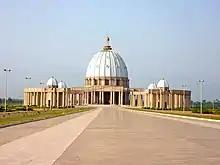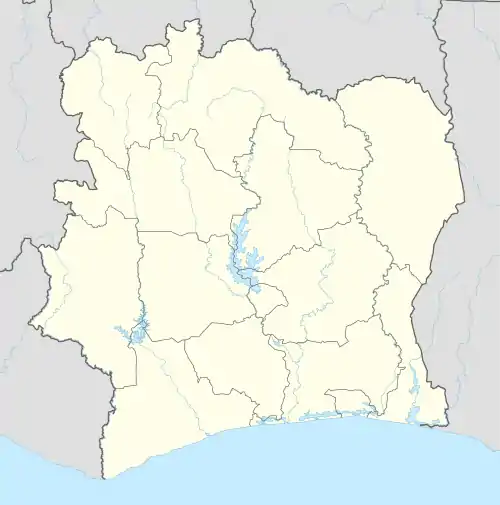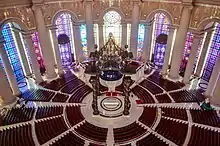Basilica of Our Lady of Peace
The Basilica of Our Lady of Peace (French: Basilique Notre-Dame de la Paix) is a Catholic minor basilica dedicated to Our Lady of Peace in Yamoussoukro, the administrative capital of Côte d'Ivoire (Ivory Coast). The basilica was constructed between 1985 and 1989 with different cost estimates given by various groups. Some stated that it cost US$175 million,[2] US$300 million,[3] ranging as high as US$600 million.[4] The designs of the dome and encircled plaza are clearly inspired by the Basilica of Saint Peter in Vatican City,[5] although it is not an outright replica.[6] The cornerstone was laid on 10 August 1985,[7] and it was consecrated on 10 September 1990 by Pope John Paul II, who had just formally accepted the basilica as a gift from Félix Houphouët-Boigny on behalf of the Catholic Church.[8][9]
| Basilica of Our Lady of Peace | |
|---|---|
Basilique Notre-Dame de la Paix | |
 | |
 Basilica of Our Lady of Peace | |
| 6°48′40″N 5°17′49″W | |
| Location | Rue de St. France, Yamoussoukro |
| Country | Côte d'Ivoire |
| Denomination | Roman Catholic |
| History | |
| Status | Minor basilica of God |
| Consecrated | 1990 |
| Architecture | |
| Architect(s) | Pierre Fakhoury |
| Architectural type | Church |
| Style | Renaissance Revival and Baroque Revival |
| Groundbreaking | 1985 |
| Completed | 1990 |
| Construction cost | US$175–600 million |
| Specifications | |
| Capacity | 18,000 |
| Length | 195 metres (640 ft) |
| Width | 150 metres (490 ft) |
| Nave width | 55 metres (180 ft) |
| Height | 158 metres (518 ft) |
| Dome diameter (outer) | 90 metres (300 ft)[1] |
| Materials | marble |
| Administration | |
| Diocese | Yamoussoukro |
| Province | Bouaké |
The basilica is not to be confused with a cathedral. Our Lady of Peace is located in the Diocese of Yamoussoukro; the Cathedral of Saint Augustine – less than 3 km (1.9 mi) away[10] — is smaller in size than the basilica but the principal place of worship and seat of the bishop of the diocese.[11]
Guinness World Records lists it as the largest church in the world, having surpassed the previous record holder, St. Peter's Basilica, upon completion. It has an area of 30,000 square metres (320,000 sq ft)[12] and is 158 metres (518 ft) high.[13] However, it also includes a rectory and a villa (counted in the overall area), which are not strictly part of the church. It can accommodate 18,000 worshippers, compared to 60,000 for St. Peter's.[14] Ordinary liturgies conducted at the basilica are usually attended by only a few hundred people.[15]
The basilica is administered by Polish Pallottines at a cost of US$1.5 million annually.[12]
Architecture

While designing it after the Vatican Basilica, Lebanese architect Pierre Fakhoury constructed the dome to be slightly lower than the Basilica of Saint Peter, but ornamented with a larger cross on top.[16][17][18] The finished height is 158 metres (518 ft).[18] The dome is more than twice the diameter of St. Peter's in Rome, 90 metres versus 41 metres (300 ft versus 136 ft). The base of the dome is much lower than St. Peter's, so the overall height is slightly less. The basilica is constructed with marble imported from Italy and is furnished with 8,400 square metres (90,000 sq ft) of contemporary stained glass from France.[19]
Columns are plentiful throughout the basilica but are not uniform in style; the smaller columns are there for structural reasons, while the bigger ones are decorative and contain elevators, rainwater evacuation from the roof and other building mechanical devices. There is enough space to seat 7,000 people in the nave, with standing room for an additional 11,000 people.[20] Apart from the basilica are two identical villas. One of the villas accommodates the clergymen who operate the basilica. A room in the other villa is reserved for papal visits, of which only one has occurred, when the basilica was consecrated.[21]
The wood chosen for the 7000 pews[22] in the Our Lady of Peace Basilica is Iroko wood.[23]
Construction

The Basilica was built by Dumez, a French construction company.[24]
The cost of the basilica was met with some controversy globally when construction began, especially as the Côte d'Ivoire was going through an economic and fiscal crisis at the time.[25] Pope John Paul II agreed to consecrate the basilica on the condition that a hospital also be built nearby. This hospital, whose construction was frozen during the politico-military crisis from 2002 to 2011, was finally completed in 2014 and opened in January 2015, at a cost of €21.3 million.[26]
Memorial
Côte d'Ivoire President Houphouët-Boigny chose his birthplace of Yamoussoukro to be the site of the new capital city of his country in 1983. As part of the plan of the city, the president wanted to memorialize himself with the construction of the basilica.[27] He is even pictured beside Jesus ascending to heaven in one stained-glass panel.[28] Due to the location of the Basilica, it was dubbed by the media as "basilica in the bush".[29] Houphouët-Boigny believed it would become a pilgrimage site for African Catholics.[30]
Notes
- List of largest church buildings in the world, fr:Basilique Notre-Dame de la Paix de Yamoussoukro
- Hadden, Briton; Luce, Henry Robinson (1 January 1992). Time. Time Inc.
- Macdonald, Jessica. "Basilica of Our Lady of Peace, Ivory Coast". Tripsavvy. Retrieved 24 September 2019.
- Stewart, Frances (22 January 2016). Horizontal Inequalities and Conflict: Understanding Group Violence in Multiethnic Societies. Springer. p. 47. ISBN 978-0-230-58272-9.
- Ostling, Richard N.; James Wilde (3 July 1989). "The Basilica in the Bush". Time. Archived from the original on 11 December 2008. Retrieved 17 November 2008.
- Massaquoi, Hans J. (December 1990). "An African's gift to the Vatican: the world's largest church – Felix Houphouet-Boigny, Basilica of Our Lady of Peace". Ebony. Johnson Publishing Co. Retrieved 24 July 2008.
- J. Gordon Melton; Martin Baumann (2010). Religions of the World: A Comprehensive Encyclopedia of Beliefs and Practices, 2nd Edition [6 volumes]. ABC-CLIO. p. 307. ISBN 9781598842043.
- Pope John Paul II (10 September 1990). "Dédicace de La Basilique de "Notre-Dame de La Paix"" (in French). Holy See. Archived from the original on 14 January 2009. Retrieved 2 January 2009. Cite journal requires
|journal=(help) - Company, Johnson Publishing (1 December 1990). Ebony. Johnson Publishing Company. pp. 116–117.
- "distance between Basilique Notre-Dame de la Paix and Cathédrale Saint-Augustin in Yamoussoukro". google. Retrieved 15 April 2018.
- "Diocese of Odienné, Cote d'Ivoire". GCatholic. gcatholic.org. Retrieved 10 September 2010.
- Strochlic, Nina (30 January 2014). "The Largest Church in the World Has The Fewest Worshippers". The Daily Beast. Retrieved 10 February 2016.
- "The biggest, longest, tallest..." The Guardian. 17 July 2004. Retrieved 22 July 2008.
- "Our Lady of Peace Basilica, Yamoussoukro". churchesguide.com. Archived from the original on 12 January 2011. Retrieved 10 September 2010.
- Mark, Monica (15 May 2015). "Yamoussoukro's Notre-Dame de la Paix, the world's largest basilica – a history of cities in 50 buildings, day 37". The Guardian. Retrieved 16 May 2015.
- Nnamdi Elleh (2002). Architecture and Power in Africa. Greenwood Publishing Group, 2002. p. 121. ISBN 9780275976798.
- Jon T. Lang; Walter Moleski (2010). Functionalism Revisited: Architectural Theory and Practice and the Behavioral Sciences. Ashgate Publishing, Ltd. p. 224. ISBN 9781409407010.
- Joe Parkinson (27 April 2017). "A Miracle at the World's Largest Church: People Are Showing Up". The Wall Street Journal.
- Wang Jie (4 May 2019). "French glass master shines a light on his soul". Shanghai Daily – via SHINE.com.
- Foley, Michael (1 November 2013). Political Leadership: Themes, Contexts, and Critiques. OUP Oxford. p. 191. ISBN 978-0-19-968593-6.
- Rice, Xan (23 October 2008). "The president, his church and the crocodiles". New Statesman. Retrieved 16 May 2015.
- Hawkes, Nigel (1 January 1990). Structures: the way things are built. Macmillan. p. 121. ISBN 978-0-02-549105-2.
- Elleh, Nnamdi (1 January 2002). Architecture and Power in Africa. Greenwood Publishing Group. p. 121. ISBN 978-0-275-97679-8.
- "Basilique Notre Dame de la Paix à Yamoussoukro". History of the VINCI Group. vinci.com. Archived from the original on 1 October 2011. Retrieved 10 September 2010.
- Brooke, James (19 December 1988). "Ivory Coast Church to Tower Over St. Peter's". The New York Times. Retrieved 16 May 2015.
- "Yamoussoukro, la capitale ivoirienne, veut sortir de l'ombre". Le Monde. Retrieved 14 October 2017.
- Shillington, Kevin (4 July 2013). Encyclopedia of African History 3-Volume Set. Routledge. p. 653. ISBN 978-1-135-45670-2.
- "Côte d'Ivoire's capital: Better late than never: Africa’s largest and most grandiose church gets a new neighbour", The Economist, dated 16 June 2012.
- Djité, Paulin G. (1 January 2008). The Sociolinguistics of Development in Africa. Multilingual Matters. p. 210. ISBN 978-1-84769-045-6.
- "Business | Basilica Rises in Ivory Coast – Cathedral Awaits Pope's Blessing | Seattle Times Newspaper". community.seattletimes.nwsource.com. Retrieved 5 March 2016.
Further reading
- Pope John Paul II (10 September 1990). "Dédicace de La Basilique de "Notre-Dame de La Paix"" (in French). Holy See. Archived from the original on 14 January 2009. Retrieved 2 January 2009. Cite journal requires
|journal=(help) - Elleh, Nnamdi (2002). Architecture and Power in Africa. New York: Praeger. ISBN 0-275-97679-3.
- Fakhoury, Pierre; Bertrand, Yann Arthus; Quino, Fernand (1993). Yann Arthus (ed.). La basilique Notre-Dame de la Paix, Yamoussoukro (in French). Liège. ISBN 2-87009-439-6.
- Fakhoury, Pierre; Bentot; Eric (1990). "Notre-Dame de la paix : l'architecture universelle". Balafon (in French). Abidjan: Air Afrique. 94: 18–25. ISSN 0378-469X. OCLC 70223073.
External links
| Wikimedia Commons has media related to Basilica of Our Lady of Peace of Yamoussoukro. |
- Basilica of Our Lady of Peace photos 2008 – an album of the Basilique images. Outside and inside views.
- Abidjan.net (2002). "La Basilique Notre-Dame-de-la-Paix de Yamoussoukro" (in French). Retrieved 6 January 2009.